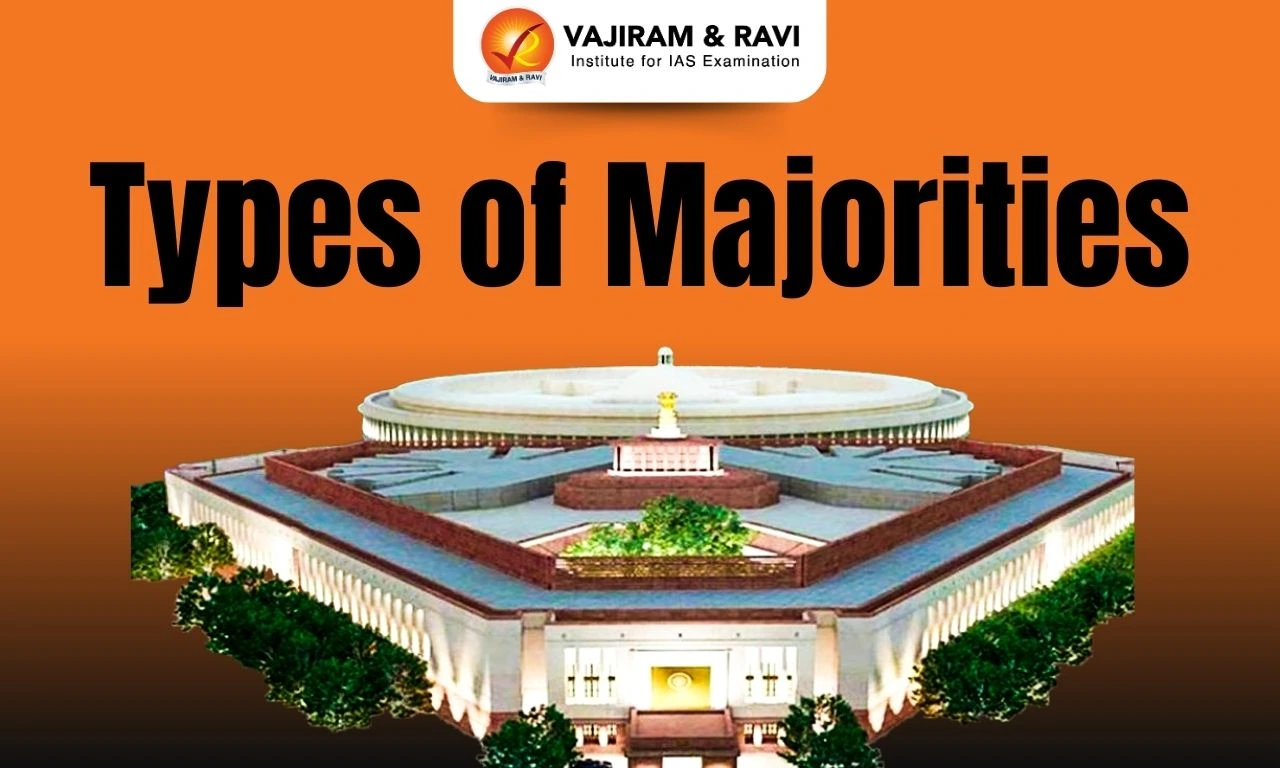What is the importance of majority in the Indian Legislature?
The Parliament of India, comprising the President, the Rajya Sabha (Council of States), and the Lok Sabha (House of the People), is the supreme legislative body of the country. One of the main functions of the Parliament is to make laws for the country's governance.
- The law-making process in the Parliament begins with the introduction of a bill and ends with the assent of the President.
- The majority in the Indian Parliament plays a crucial role in deciding the fate of bills and policies.
- The Indian Constitution does not explicitly categorize the types of majorities required for passing different bills, but the interpretation of the Constitution provides four types of majorities:
- Simple majority
- Absolute majority
- Effective majority
- Special majority
What are the different types of majorities?
| Type of Majority | Constitutional Provisions | Application |
|
Simple Majority: the majority of more than 50% of the members present and voting. It is also known as functional or working majority. |
|
|
| Absolute majority: the majority of more than 50% of the House’s total membership. | Note: Parliament or the State legislature does not use the absolute majority for normal business. |
|
|
Effective Majority: the majority of more than 50% of the effective strength of the House. Example of Effective strength: If 15 seats out of a total 545 seats in Lok Sabha are vacant. Then effective strength is 545-15 = 530. In this case, the effective majority will be 265. |
|
|
| Special Majority Type-1: Majority by two-thirds of members present and voting. |
|
|
| Special Majority Type-2: Majority of two-third members present and voting along with 50% of the total strength of the House. |
|
|
| Special Majority Type-3: A majority of two-thirds members present and voting supported by more than 50% of the state legislatures by a simple majority. |
|
Used to pass Constitutional Amendment bills involving federal matters:
the Union and the States.
|
| Special Majority Type-4: Majority of 2/3rd of the total strength of the House. |
|
|
Last updated on November, 2025
→ Check out the latest UPSC Syllabus 2026 here.
→ Join Vajiram & Ravi’s Interview Guidance Programme for expert help to crack your final UPSC stage.
→ UPSC Mains Result 2025 is now out.
→ UPSC Notification 2026 is scheduled to be released on January 14, 2026.
→ UPSC Calendar 2026 is released on 15th May, 2025.
→ The UPSC Vacancy 2025 were released 1129, out of which 979 were for UPSC CSE and remaining 150 are for UPSC IFoS.
→ UPSC Prelims 2026 will be conducted on 24th May, 2026 & UPSC Mains 2026 will be conducted on 21st August 2026.
→ The UPSC Selection Process is of 3 stages-Prelims, Mains and Interview.
→ UPSC Result 2024 is released with latest UPSC Marksheet 2024. Check Now!
→ UPSC Prelims Result 2025 is out now for the CSE held on 25 May 2025.
→ UPSC Toppers List 2024 is released now. Shakti Dubey is UPSC AIR 1 2024 Topper.
→ UPSC Prelims Question Paper 2025 and Unofficial Prelims Answer Key 2025 are available now.
→ UPSC Mains Question Paper 2025 is out for Essay, GS 1, 2, 3 & GS 4.
→ UPSC Mains Indian Language Question Paper 2025 is now out.
→ UPSC Mains Optional Question Paper 2025 is now out.
→ Also check Best IAS Coaching in Delhi
Types of Majorities FAQs
Q1. What are some important Constitutional amendments passed under Article 368 (special majority of parliament and ratification of 50% of the state legislature)?+
Q2. Has Rajya Sabha ever passed a resolution under Article 249? +
Tags: quest types of majorities

















